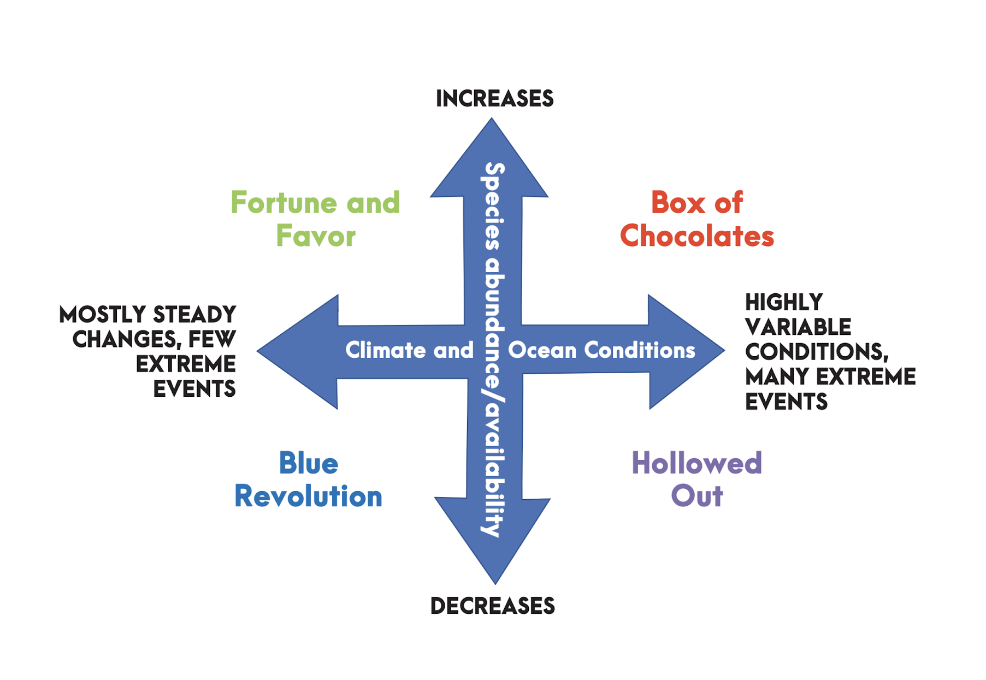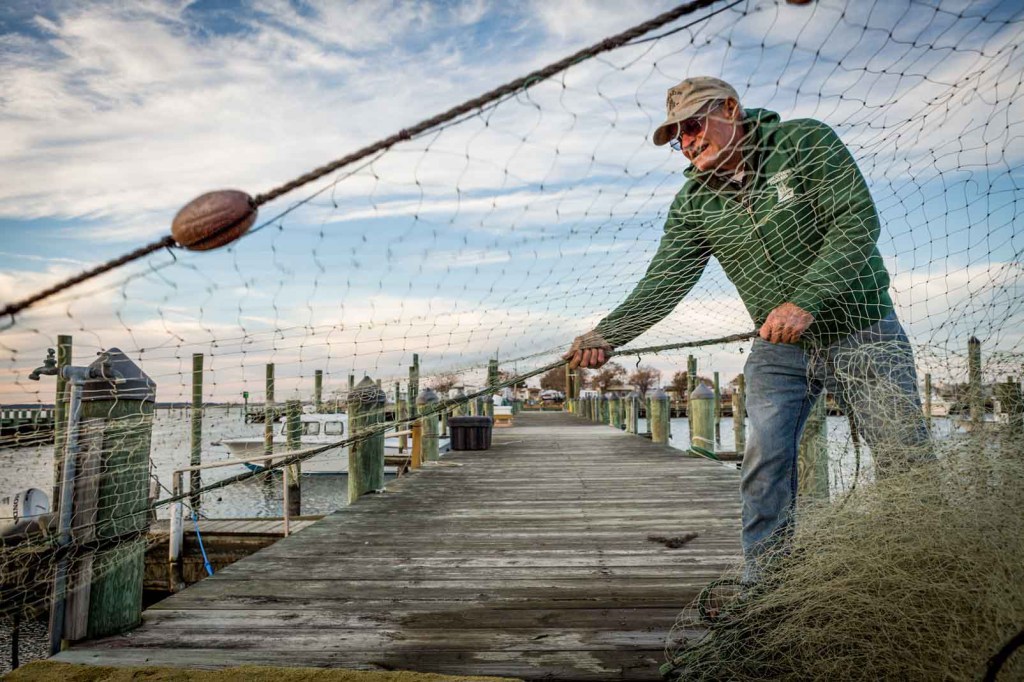From managing natural resources to running a business, or even checking the weather forecast when packing for a vacation, having an understanding about the future helps us make informed decisions in the present moment.
Yet, the process of understanding what the future holds, and then deciding how to act accordingly, can get complicated when that future is highly uncertain.
For example, the impacts of climate change on our oceans present an uncertain future. Global oceans have absorbed approximately 90% of the heat and 30% of the CO2 produced by humans. This is leading to a cascade of impacts on marine ecosystems, such as changes in ocean chemistry, and shifts in where fish species live and how fast they grow.
The consequences of failing to adapt to climate change impacts on fisheries include serious economic, social, and cultural ramifications for thousands of fishing-dependent communities and fishing supply chain businesses. In October 2022, the Bering Sea snow crab fishery was closed for the first time for reasons possibly attributed to climate change, leading to sweeping losses of over $150 million that are impacting local fishing businesses to restaurants.
Managing natural resources, like fisheries, requires balancing the needs of nature and people. Climate change adds complexity to these already dynamic systems, and it is increasing uncertainty that is straining existing management policies and institutions.
So how can we understand our future oceans and respond appropriately? One way to prepare for the uncertainty facing oceans and marine fisheries is by carefully thinking through a range of possibilities that may occur. A tool called “scenario planning” can help.
What is Scenario Planning?
Scenario planning is a forward-thinking, iterative process that is used in a variety of disciplines to plan for the future by accounting for the spectrum of uncertainty. Scenario planning presents a structured process to evaluate what may happen given the range of plausible changes in the world, and then explore our underlying assumptions and perceptions, as well as the range of uncertainty.
What sets scenario planning apart from other planning tools is the use of stories—detailed accounts of different potential futures. These stories, or “scenarios”, are constructed in a collaborative setting by a diverse group of stakeholders. The scenarios are designed to cover a range of futures that could unfold—not just the most likely ones. Equipped with these narratives about potential futures, stakeholders can then explore appropriate responses or actions, and prepare for a range of future conditions.
 Scenario planning has been used in a variety of settings, from businesses to public agencies. Private companies often use scenarios to understand future markets and make better decisions. In addition, the Joint United Nations Program on HIV/AIDS applied scenario planning to confront the AIDS epidemic. In a conservation context, the USA National Park service has used scenario planning to better understand and prepare for a variety of climate change impacts on protected ecosystems and park operations. Although used by diverse organizations and contexts, scenario planning has a common outcome of a stronger ability to plan and take action when facing an uncertain future.
Scenario planning has been used in a variety of settings, from businesses to public agencies. Private companies often use scenarios to understand future markets and make better decisions. In addition, the Joint United Nations Program on HIV/AIDS applied scenario planning to confront the AIDS epidemic. In a conservation context, the USA National Park service has used scenario planning to better understand and prepare for a variety of climate change impacts on protected ecosystems and park operations. Although used by diverse organizations and contexts, scenario planning has a common outcome of a stronger ability to plan and take action when facing an uncertain future.
Drawing lessons and methodologies from other fields, scenario planning is being increasingly applied to marine resources management. Fisheries is one key area where scenario planning is being used to prepare for impacts of climate change. In 2020, NOAA Fisheries staff published a technical guidance document to introduce fishery managers to scenario planning processes.
“In order to respond to the uncertainty facing our oceans, we need to think creatively about what types of situations we will face”, says Rich Bell, a Lead Fisheries Scientist at The Nature Conservancy, who has supported scenario planning processes on USA East and West Coasts. “Scenario planning brings these plausible futures to life, and helps us chart a structured course to respond.”
“One of the most important things to realize about scenario planning is that the process is not trying to plan for a single future outcome,” continues Bell. “Rather, the goal is to develop scenarios that represent an array of potential futures. Then, we can evaluate which actions could work across that broad array.”
In the Real World: Applying Scenario Planning in Marine Fisheries from Pacific to Atlantic
Along the East and West Coasts of the United States, climate change is impacting marine fisheries — from highly migratory species such as tunas, to more sedentary groundfish species like rockfish. At both federal and state levels, scenario planning is being employed as an adaptation tool.
For example, in 2018, a scenario planning process was initiated with the Pacific Fisheries Management Council (PFMC), one of 8 regional federal fisheries management councils in the United States. As part of a Climate and Communities Initiative, activities to engage stakeholders in scenario planning were led by the PFMC, with support from The Nature Conservancy and other partners.
In order to first develop scenarios for West Coast fishing communities, PFMC and The Nature Conservancy jointly hosted a 2020 workshop where over 80 stakeholders, including scientific experts, fishing industry, and government agency staff, outlined the suite of plausible futures. Four main scenarios were developed (Figure 1), with detailed descriptions and examples of what may happen to key species, such as market squid or Northern anchovy.

With these four scenarios in hand, stakeholders considered their implications — or what life in the future might look like — and identified corresponding actions that fishing communities and the PFMC could take. For example, under the scenario marked by highly variable ocean conditions and increases in species abundance (Figure 1, “Box of Chocolates” scenario), stakeholders and institutions need to be prepared for volatility both in the ecosystem and seafood markets.
To address these scenarios, the Council recommended investing in new science to add early-warning indicators into fishery management plans, as well as assessing fishing community vulnerability to climate impacts to help prioritize actions. The scenario planning recommendations were approved by the Pacific Council at their September 2021 meeting.
Building off the West Coast experience, the East Coast Climate Change Scenario Planning Initiative is bringing together scientists, managers, and fishing community members to explore and plan for impacts of climate change in Atlantic fisheries. Uniquely, this process involves the five major fisheries management institutions on the East Coast: the Atlantic States Marine Fisheries Commission (ASMFC), New England Fishery Management Council (NEFMC), Mid-Atlantic Fishery Management Council (MAFMC), South Atlantic Fishery Management Council (SAFMC), and NOAA Fisheries. These institutions include many representatives from all state fishery management agencies from Maine to Florida.
“The fish we as anglers love to catch, eat and/or release today are vastly different in type and abundance than what we caught ten years ago, because of climate change,” said fishing guide and outdoor writer Captain Dave Monti, who attended planning sessions. “The Scenario Planning sessions helped shine a light on the urgent challenges we face and will hopefully lead to an action plan to sustain ocean health and fisheries.”

The East Coast initiative included research to summarize evidence of known and predicted climate impacts to ecosystems and economies. Subsequently, key stakeholders were convened in a 3 day workshop in 2022 to develop draft scenarios. The East Coast Process is now focused on surfacing and refining solutions for review and discussion at four public meetings, followed by a Managers’ Summit to consider specific actions necessary to sustain fisheries despite climate impacts.
Learning from these scenario planning experiences at the federal level allows lessons to be taken to the state level. One example is the scenario planning work being undertaken for Oregon’s state-managed Dungeness crab fishery, the state’s most economically valuable single species commercial fishery.
“We’ve taken methodologies from the federal scenario planning process, and adapted these to the state level,” says Gway Kirchner, who has led the scenario planning with the Pacific Fishery Management Council, in close collaboration with Pacific stakeholders. “We recently completed a scenario planning exercise in Oregon’s state-managed Dungeness Crab fishery, and see strong potential for scenario planning to support other state-managed fisheries in building climate change resilience — both in Oregon and across the U.S..”
From Science to Policy
Responding to the impacts of climate change necessitates creative approaches that involve multiple, diverse stakeholders. Scenario planning is one tool in the climate adaptation toolbox that can be used to prepare for an uncertain future. Explicitly incorporating climate science into the development of stakeholder-driven scenarios ultimately ensures that resulting policy recommendations address key climate vulnerabilities, both ecologically and socially.
Restoring and maintaining ocean health will require significant adaptation of fishery management systems and practices. Adaptation action will be needed at multiple scales from individual fishermen, to fishing communities and supply chains, to fisheries science, management and governance institutions.
“The challenge now is to put the results of scenario planning into practice, to ensure managers and communities can be better prepared,” says Kate Kauer, Associate Director for the California Oceans Program at The Nature Conservancy. “Climate-ready fisheries management can allow both people and nature to adapt to the realities facing our oceans under climate change.









Join the Discussion